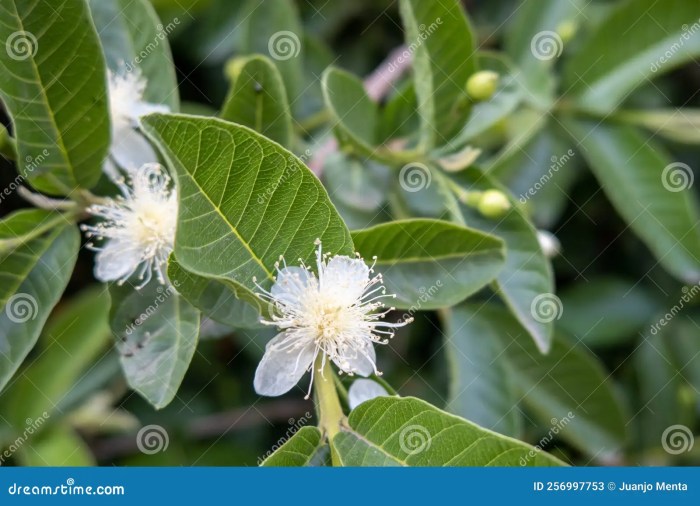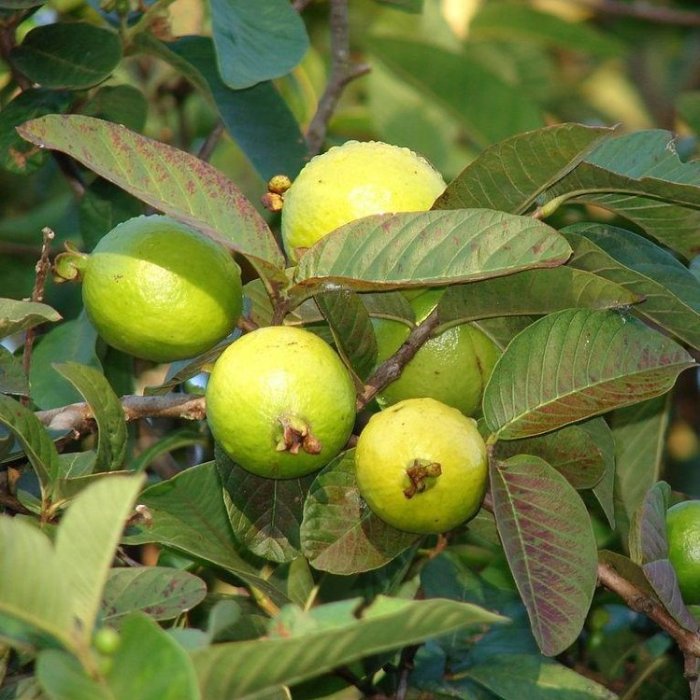Botanical Characteristics of the Mexican White Guava Tree
Mexican white guava tree plant – The Mexican white guava, a delightful addition to any tropical garden, possesses unique botanical features that distinguish it from other guava varieties. Understanding these characteristics helps in proper cultivation and appreciation of this fruit-bearing tree. Let’s delve into the specifics.
Size and Growth Habit
A mature Mexican white guava tree typically reaches a height of 15 to 25 feet (4.5 to 7.5 meters), though it can sometimes grow taller under ideal conditions. Its growth habit is generally rounded and spreading, creating a pleasant shade. The branches are relatively sturdy and often grow somewhat horizontally, leading to a somewhat bushy appearance. Pruning can be used to maintain a desired size and shape, promoting better fruit production.
The Mexican white guava, prized for its sweet fruit, requires well-drained soil and ample sunlight. Similar citrus fruit tree cultivation techniques apply; for instance, understanding the basics of root systems is crucial, much like when learning how to plant a tangerine tree, as detailed in this helpful guide: how to plant a tangerine tree. Proper planting ensures healthy growth, leading to a bountiful harvest of both tangerines and, in this case, delicious Mexican white guavas.
Leaf Morphology
The leaves of the Mexican white guava are elliptical to ovate, meaning they are oval-shaped with a slightly pointed tip. They are typically 2 to 4 inches (5 to 10 centimeters) long and 1 to 2 inches (2.5 to 5 centimeters) wide. The leaf texture is smooth to slightly leathery, and the color is a deep, glossy green on the upper surface, often paler underneath.
New growth may exhibit a slightly reddish tint. The leaves are oppositely arranged on the stems, meaning they grow in pairs across from each other.
Flowering Process and Flower Characteristics
The Mexican white guava tree flowers profusely, typically in spring and summer. The flowers are white, possessing four petals and numerous stamens (male reproductive parts) giving them a fluffy appearance. They are relatively small, usually about 1 inch (2.5 centimeters) in diameter. The flowers are sweetly fragrant, attracting pollinators such as bees and butterflies, which are essential for fruit production.
These flowers are hermaphroditic, meaning they contain both male and female reproductive organs.
Fruit Characteristics
The fruit of the Mexican white guava is generally smaller than that of the common red guava, usually ranging from 1 to 2 inches (2.5 to 5 centimeters) in diameter. The shape is typically round or slightly pear-shaped. When ripe, the fruit’s skin is smooth and pale yellow to creamy white, sometimes with a slight blush of pink. The texture of the ripe fruit is soft and juicy, with a slightly less firm flesh compared to some red guava varieties.
Comparison with Other Guava Varieties
| Variety | Fruit Size | Fruit Color | Taste Profile |
|---|---|---|---|
| Mexican White Guava | 1-2 inches (2.5-5 cm) | Pale yellow to creamy white | Sweet, slightly tart, delicate flavor |
| Red Guava | 2-4 inches (5-10 cm) | Red to pink | Sweet, more intensely flavored, sometimes slightly acidic |
Cultivation and Care of the Mexican White Guava Tree: Mexican White Guava Tree Plant

Growing a thriving Mexican white guava tree requires understanding its specific needs. Providing the right conditions will reward you with a bountiful harvest of delicious fruit. This section details the essential aspects of cultivating and caring for this delightful tree.
Ideal Soil Conditions
Mexican white guava trees prefer well-drained soil that is slightly acidic to neutral. The ideal pH range is between 6.0 and 6.5. Heavy clay soils should be amended with organic matter, such as compost or well-rotted manure, to improve drainage and aeration. Poor drainage can lead to root rot, a serious problem for guava trees. Adding organic matter also enhances the soil’s water retention capacity, beneficial during dry spells.
Sandy soils, while well-draining, may require more frequent watering to maintain adequate moisture.
Sunlight Requirements
Mexican white guava trees thrive in full sun, requiring at least six to eight hours of direct sunlight daily. Insufficient sunlight can lead to reduced fruit production and weaker growth. While they can tolerate some shade, particularly during the hottest part of the day in extremely hot climates, optimal growth and fruiting are achieved with ample sunlight exposure.
Consider the tree’s location carefully when planting to ensure it receives adequate sunlight throughout the day.
Watering Techniques for Different Growth Stages
Watering requirements vary depending on the growth stage of the tree and environmental conditions. Young, newly planted trees require more frequent watering to establish a strong root system. Consistent moisture is crucial during this phase, but avoid overwatering, which can lead to root rot. Once established, mature trees are more drought-tolerant but still benefit from regular watering, especially during dry periods.
Deep, infrequent watering is preferred to shallow, frequent watering, encouraging deeper root growth. During fruiting, consistent moisture is vital for optimal fruit development and size.
Common Pests and Diseases and Their Control
Several pests and diseases can affect Mexican white guava trees. Common pests include guava fruit flies, scale insects, and mealybugs. These can be controlled through a combination of methods. Regular inspection is crucial for early detection. Natural methods such as introducing beneficial insects or using insecticidal soap can be effective against many pests.
For more severe infestations, chemical control may be necessary, always following label instructions carefully. Common diseases include fungal diseases like anthracnose and leaf spot. Proper sanitation, including removing fallen leaves and infected branches, helps prevent fungal diseases. Applying fungicides, as needed, can control fungal infections. Maintaining good tree health through proper cultivation practices is the best defense against pests and diseases.
Pruning Techniques, Mexican white guava tree plant
Regular pruning is essential for maintaining the health and shape of the Mexican white guava tree. Pruning helps improve air circulation, sunlight penetration, and fruit production. It also removes dead, damaged, or diseased branches, preventing the spread of pests and diseases.
- Training young trees: This involves shaping the tree’s structure during its early years to create a strong framework for future growth and fruit production.
- Thinning: Removing overcrowded branches to improve air circulation and sunlight penetration, promoting better fruit development.
- Removing dead or diseased branches: This prevents the spread of disease and maintains the tree’s overall health.
- Size control: Pruning to limit the tree’s size and manage its growth, particularly important in smaller spaces.
- Harvest pruning: Removing branches that have finished fruiting to encourage new growth and future fruit production.
Nutritional Content and Health Benefits

The Mexican white guava, a delightful tropical fruit, boasts a rich nutritional profile offering a wide array of health benefits. Its sweet, slightly tart flavor masks a powerhouse of vitamins, minerals, and antioxidants, making it a valuable addition to a healthy diet. Let’s delve into the specifics of its nutritional composition and explore the positive impacts it can have on your well-being.
Nutritional Composition of Mexican White Guava
Mexican white guavas are an excellent source of Vitamin C, a potent antioxidant crucial for immune function and collagen production. They also contain significant amounts of Vitamin A, essential for vision and cell growth, and various B vitamins that support energy metabolism and nerve function. Minerals such as potassium, manganese, and fiber are also present in considerable quantities. The precise nutritional content can vary slightly depending on factors like growing conditions and ripeness.
However, a typical serving provides a substantial contribution to daily recommended intakes of several key nutrients. This makes it a truly remarkable fruit for overall health and vitality.
Health Benefits of Consuming Mexican White Guava
The impressive nutritional profile of the Mexican white guava translates to numerous potential health benefits. Its high Vitamin C content strengthens the immune system, protecting against infections and illness. The fiber aids in digestion and promotes regularity, contributing to gut health. The antioxidants combat free radicals, reducing the risk of chronic diseases like heart disease and certain cancers.
The potassium content supports healthy blood pressure, and the manganese plays a role in bone health and metabolism. Regular consumption may also contribute to improved skin health and increased energy levels. Many people find that incorporating this fruit into their daily routine results in a noticeable improvement in their overall health and well-being.
Comparison of Nutritional Content with Other Common Fruits
The following table compares the nutritional content of the Mexican white guava with that of two other popular fruits, oranges and mangoes, per 100g serving. Note that values may vary slightly depending on the source and specific variety.
| Nutrient | Mexican White Guava | Orange | Mango |
|---|---|---|---|
| Vitamin C (mg) | 228 | 53 | 60 |
| Vitamin A (µg) | 30 | 5 | 70 |
| Potassium (mg) | 250 | 236 | 170 |
| Fiber (g) | 5 | 2 | 1.6 |
Graphic Representation of Nutritional Profile
Imagine a circular chart, a pie chart, divided into segments representing the major nutrients in Mexican white guava. The largest segment would be dedicated to Vitamin C, reflecting its high concentration. Substantial segments would represent fiber and potassium. Smaller segments would depict Vitamin A and other minerals and vitamins. Each segment would be color-coded for easy identification, with a key provided to indicate which nutrient each color represents.
The chart would visually highlight the fruit’s rich nutrient density, emphasizing its importance in a balanced diet. The overall visual impact would be bright and inviting, reflecting the fruit’s appealing color and taste. The percentages within each segment would be clearly labeled, providing a quantitative understanding of the nutritional breakdown.
Questions Often Asked
What is the lifespan of a Mexican white guava tree?
With proper care, a Mexican white guava tree can live for several decades, even exceeding 50 years in optimal conditions.
Are Mexican white guavas self-fertile?
While some self-fertility may occur, cross-pollination with other guava varieties often leads to increased fruit production and better fruit set.
Can I grow a Mexican white guava tree in a pot?
Dwarf varieties are suitable for container growing, but larger trees will require significant space and regular pruning.
What are the best companion plants for Mexican white guava trees?
Companion planting choices depend on local climate and soil conditions, but nitrogen-fixing plants can improve soil health, benefiting the guava tree.
